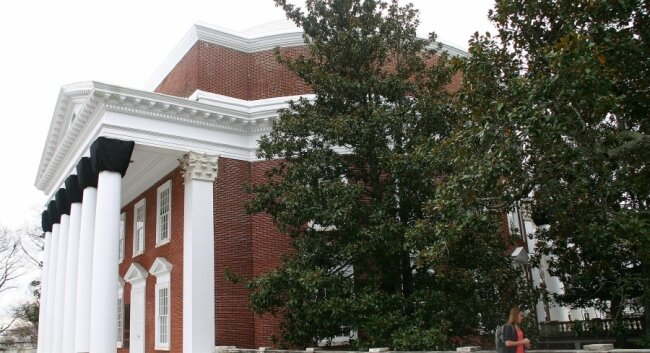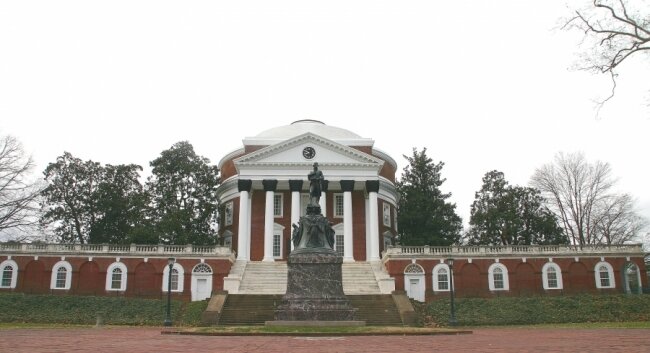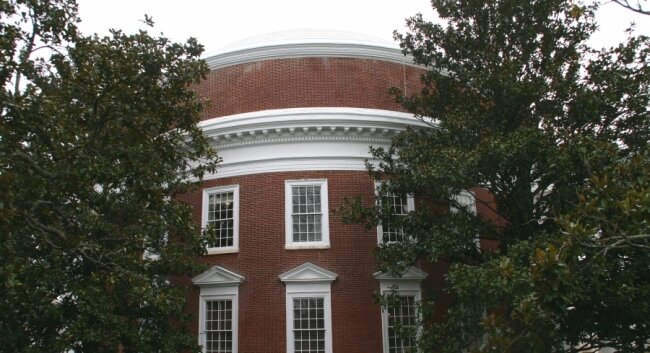Rotunda rehab: Good-bye and good-riddance to magnolias?
-
 Over 3,000 people signed a petition opposing the removal of the old magnolias that surround the Rotunda.Photo by Dave McNair
Over 3,000 people signed a petition opposing the removal of the old magnolias that surround the Rotunda.Photo by Dave McNair -
 "The magnolias, as wonderful as they are, compromise the way we see the Rotunda," says one UVA architectural historian.Photo by Dave McNair
"The magnolias, as wonderful as they are, compromise the way we see the Rotunda," says one UVA architectural historian.Photo by Dave McNair -
 Magnolias crowd the Rotunda. But should they be removed?Photo by Dave McNair
Magnolias crowd the Rotunda. But should they be removed?Photo by Dave McNair
As UVA gears up to begin a $4.7 million roof replacement project for the Rotunda, part of a planned $50 million restoration of Thomas Jefferson's famous centerpiece on the Lawn, a major visual transformation of the UNESCO World Heritage site (along with Monticello, one of only four in the country) could take place before the first piece of old sheet metal is removed.
According to a statement by University architect David Neuman, the six 100-year-old magnolias in the two courtyards that flank the Rotunda need to be removed, both because they have become a danger to the structure and because of the need to erect scaffolding for the roof work. What's more, according to UVA'a leading Lawn historian, the giant magnolias, which have grown to the roof line and crowd the Rotunda's curved walls, would mostly likely displease the structure's original architect, who preferred that his major buildings "stand up and stand out" against the horizon.
However, according to over 3,000 people who signed an online petition opposing the removal of the trees, they should stay up and stay put.
As one petitioner put it, "I don't want to stand idly by as they trample over common sense and due decency in the name of sycophantic adherence to the plans of a man who's been dead for almost two hundred years."
As a result, UVA has done some backpedaling. A week ago, President Teresa A. Sullivan fired off an email to students, who initiated the petition, assuring them that no final decision has been made on the fate of the trees, and that one wouldn't be made until the beginning of the year after further study.
Still, UVA Architectural History department chair Richard Guy Wilson, whose most recent book is about Thomas Jefferson's design of his University, says the decision is clear.
"I am in many ways a tree-hugger and don't like to see them cut down," says Wilson, "but they do mar his concept of how the Rotunda should be seen."
Wilson contends that Jefferson liked his buildings, especially the important ones, to be clearly seen on the horizon. "With plenty of sky behind them, to stand up and stand out," says Wilson, noting that Monticello, the State Capitol, and Poplar Forest all "stand up" and are not overly encumbered by trees.
Wilson says the Rotunda magnolias were planted sometime after the reconstruction of the building after the 1895 fire that destroyed most of Jefferson's original structure, probably around 1920.
"The magnolias, as wonderful as they are, compromise the way we see the Rotunda," says Wilson.
Indeed, a reporter noticed that three of the big magnolias are essentially growing up the side of the building, their branches reaching out to touch the windows. Standing on the north and south side of the terrace, the width of the trees crowds the view of the building.
Also, as Wilson points out, the trees are growing in the courtyards created by architect Stanford White.
"Magnolias, while a wonderful tree," observes Wilson, "are not that inviting to sit under."
Ironically, of course, while the University insists on remaining loyal to Jefferson's intentions when it comes to the Lawn, the exterior of the Rotunda as it exists today is mostly the work of White, while the interior is the result of a 1974-76 remodeling by architecture firm Ballou and Justice that gutted White's interior. As UVA historic preservation planner Brian Hogg told the alumni magazine a few years ago, "The only thing that’s really left of Jefferson is the brick." For instance, the design scheme of the replacement roof will mimic White's design, not Jefferson's original.
According to Neuman's office, the roof work will begin in March 2012 and won't be finished until May 2013. As for the the magnolias, odds are the decision will be to remove them, as they have outgrown the courtyards where they were planted and mar the full view of the Rotunda, but it won't be without some grumbling.
10 comments
Thanks Dave. After reading this I have changed my mind. The magnolias are beautiful, but the Rotunda is a special case. I think Richard Wilson's explanation is correct, and that we will see this architectural gem in an entirely new light without the trees, that have overgrown the space.
If they can do it at Popular Forest - why not here ?
Even though the trees weren't planted in Jefferson's day they are closely tied to his legacy by their proximity to the Rotunda, so, how about this - magnolia wood from the Jefferson/White Rotunda trees as gifts for next holiday season. Does anyone know anything about magnolia wood ?
http://www2.newsadvance.com/news/2011/nov/27/poplar-forest-wood-renewed-...
and you thought the JPA bridge was taking too long- IT'S A ROOF!.............and they are TREES!
Good old UVa...the trees mar jeff's concept. Dudes-The trees are part of the received heritage of the Rotundra- you have no right to privilege one aspect and say that is more authentic. As toJeff -chop ALL the lawn trees down.Reroute the traffic from the avenue,get rid of those silly modern key holes and please tearoof that hedious parapet on the Pav.
re " The trees are part of received heritage of the Rotundra- you have no right to privilege one aspect and say that is more authentic"
Terrible logic. You could use that to argue that the bird crap on the statues and leaves in the gutters can't be touched.
If Jefferson wanted only open vistas why did he personally plant so many trees around Monticello, Dr Wilson?????
The discussion initiated here by "Sean" violated our posting policy (located at the bottom of this page) and so his comments were removed. To prevent confusion on this thread, comments made by those who responded to "Sean" were also removed, though none of those post were in violation of our policy.
Thanks (op cit) Mailwalker, you have made my argument, perfectly! "'you could use that argument" --to cut down trees!
"Crown Reduction Pruning"
This does NOT have to be "ALL-OR-NOTHING"! The magnolias can be reduced in height and pruned back from the building. "Crown Reduction Pruning" is a specific pruning procedure that is recognized in the tree care industry as the correct technique for reducing the overall size, height, and/or branch spread of a tree. When performed properly by a qualified arborist, crown reduction pruning increases structural integrity, encourages health, minimizes safety issues and maintains the natural habit of growth.
Why not a compromise here? I just had a look at the trees. There are 7 of what aboviously were 8 trees planted originally left. They were planted in the four corners of the squares between the upper walkways and the dome. In the eastern square the southwestern tree closest to the dome is already gone. The other three are healthy and attractive. In the western square, the southwestern tree farthest from the dome has got little life left in it, and is a bit of an eyesore. It seems to me that it could be felled and replaced, and that all four of the trees farthest from the dome could remain and still allow for the roof repair scaffolding for that ridiculously priced replacement/repair.
So why don’t they cut down the three trees that are closet to the dome and leave the other four? That would prevent the roots from endangering the dome, and there isn’t any foundation to speak of for the far walkway anyway. Cut three, leave three, and replace the one that is almost dead.